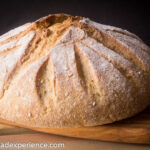Description
This Sourdough Semolina Einkorn Bread, made with sourdough, semolina flour and Einkorn flour and baked in a ceramic Dutch Oven, has a rich and nutty flavor.
Ingredients
Sourdough Build (15% of the total flour)
- 75 grams / 100% all-purpose Einkorn (or bread flour)
- 94 grams / 125% water
- 15 grams / 20% mature culture (I used my apple starter)
Final Build
- 300 grams Semolina flour (I used Bob’s Red Mill semolina)
- 125 grams whole grain Einkorn flour
- 300 grams water
- 8 grams salt
- 25 grams sesame seeds, additional for sprinkling on top (optional)
Instructions
Day 1: Evening – Start the Liquid Levain
- In a large bowl, prepare the liquid levain 12 to 16 hours before you plan to mix the final dough.
- If your starter hasn’t been fed recently, feed it several hours before you plan to start the final build.
- Cover and let it rest at room temperature (about 70 degrees F.). My house was about 64 degrees F. so I let it rest about 14 hours before it was ready to use.
Day 2: Morning – Mix the Final Dough
- In a separate bowl, whisk together the dry ingredients, including the sesame seeds, and set aside.
- Pour about 200 grams of the water over the starter, and reserve the rest of the water to use as needed. Stir using a Danish dough whisk or wooden spoon to break up the starter.
- Add the dry ingredients to the wet ingredients and stir to combine. When the dough is too heavy to mix by hand, use wet hands to thoroughly incorporate the dough. Add the reserved water as needed until there are no bits of flour and the dough has come together.
Bulk Ferment
- Remove the dough to a floured surface and let it rest for 20 minutes. You can cover the dough with the bowl or plastic wrap during the rest period.
- Fold the dough, then gently shape it into a ball. Place it in a clean, lightly greased bowl and turn to coat with oil.
- Cover and let it bulk proof for 2 hours. Perform 2 folds during the first hour – 1 fold every 30 minutes. Then let the dough rest covered for the final hour.
Final Proof
- Remove the dough to a lightly floured surface and shape into a rough ball. Let rest for 20 minutes.
- Shape the dough into a tighter boule and place seamside up in a heavily-floured, lined banneton proofing basket. I use a mixture of white/rice flour to dust the liners. You can also use a mixture of semolina/white flour.
- Let the loaf proof for 2 hours at about 76 degrees F. or up to 18 hours at about 42 degrees F.
Baking the Loaf
- Preheat the oven to 450 degrees F. for about 45 minutes with a Dutch Oven on the bottom shelf.
- Carefully remove the hot Dutch Oven to a protected workspace (a wooden board or heavy towel)
- Gently flip the loaf onto the bottom of the Dutch Oven and carefully score the loaf using the pattern of your choice. Alternately, omit the scoring and allow the loaf to open up on its own. I happen to like scoring so I usually just score it.
- Transfer the Dutch Oven to the oven using heavy oven mitts and bake the loaf with the lid on for 25-30 minutes. Remove the lid and continue baking an additional 10-15 minutes or until the loaf is brown and crusty on the outside.
- Remove the baker to a protected surface. Then remove the loaf to a wire rack to cool before slicing and serving.
Notes
The original formula utilized a liquid culture (meaning the sourdough is fed with more water than flour). The starter I used is 100% hydration. I didn’t adjust the liquid in the starter or the amount of liquid used in the levain.
I used all-purpose Einkorn in the levain. Einkorn doesn’t soak up water the same as bread flour, but I decided to make any necessary adjustments in the final mix.
For the final mix, I added more water, because whole grain Einkorn soaks up more water although it takes a bit longer for it to absorb it.
If you use regular bread flour in this bread, add the water gradually. You may need more or less depending on the flour used.
Both Einkorn and Semolina perform better when mixed by hand. If you do use a mixer, keep a close watch on the dough so that it doesn’t break down in the mixer.
- Category: Semolina Bread
